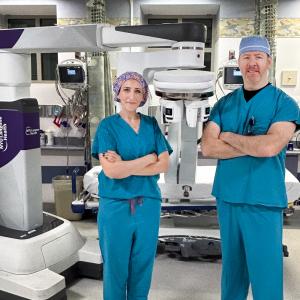Routine Biopsy Should Be Discouraged at Six Months After PGCA

NYU Langone urologists, led by Dr. James S. Wysock, assess the usefulness of three diagnostic tests to detect prostate cancer after partial-gland cryoablation.
Photo: NYU Langone Staff
Partial-gland cryoablation (PGCA)—destroying cancerous tissue within the prostate while sparing surrounding normal tissue—has significant quality of life advantages for men with localized prostate cancer. Compared with radical prostatectomy, the procedure is associated with faster recovery, fewer complications, and lower cost. However, controversy remains about how best to monitor patients for new or recurring disease.
In a recent study, researchers at NYU Langone’s Department of Urology and Perlmutter Cancer Center sought to assess the usefulness of prostate-specific antigen (PSA) testing, MRI, and biopsy in detecting in-field disease six months after PGCA. Their results suggest that early follow-up isn’t justified in the overwhelming majority of cases. In the study cohort of 70 patients with prostate cancer, significant disease was detected in only 1, and neither PSA nor MRI was a reliable predictor of persistence.
“Based on our data, six months may be too soon to identify disease persistence,” says lead author James S. Wysock, MD, a urologic oncologist at the Smilow Comprehensive Prostate Cancer Center and assistant professor in the Department of Urology at NYU Langone. “It’s possible that PSA and MRI may prove to be more useful predictors at longer follow-up if the detection rates of prostate cancer increase.”
Biopsy Reveals Low Rate of Disease at Six Months
In a recent study published in Prostate Cancer and Prostatic Diseases, researchers analyzed outcomes for 70 men who underwent PSA testing, MRI, and prostate biopsy at NYU Langone 6 months after PGCA, the standard protocol recommended by expert consensus statements. Five patients (7.1 percent) showed disease persistence according to biopsy results; of these, 4 cases were considered low risk (Gleason grade group 1) and clinically insignificant.
“It’s possible that PSA and MRI may prove to be more useful predictors at longer follow-up if the detection rates of prostate cancer increase.”—James S. Wysock, MD
“We are monitoring our PGCA outcomes with a robust treatment registry and are encouraged that the six-month biopsy results demonstrate a remarkably low rate of cancer in the ablation zone, bolstering our confidence in the accuracy of our ability to target and treat the disease,” says Dr. Wysock.
The results are not necessarily generalizable to all patients as favorable outcomes following PGCA are associated with treatment at high-volume centers with extensive experience and expertise in treating prostate cancer. However, the findings suggest that biopsies at six months are unnecessary and should not be performed automatically.
PSA and MRI Unreliable Predictors of Cancer Persistence at Six Months After Prostate Biopsy
Investigators also ascertained the usefulness of measuring PSA and MRI and found that neither reliably predicted localized cancer persistence. None of the patients in the study showed an increase in PSA, and changes in PSA did not correlate with cancer detection. Similarly, MRI scan results did not necessarily correlate with disease detection on biopsy.
Over the six-month follow-up period, changes in PSA were highly variable, researchers reported. Of 6 men who experienced declines of less than 25 percent in PSA, only 1 had prostate cancer, suggesting that modest changes in PSA do not correspond with higher rates of disease at 6 months. Of 7 MRI scans with suspicious results, only 1 was associated with cancer, while 4 out of 63 non-suspicious scans showed cancer.
The authors noted that low rates of persistent disease at six months are not necessarily predictive of disease control at two years. In a previous study, 25 percent and 22 percent of men showed Gleason grade 1 and >1 cancers, respectively, after 2 years, compared with only 12.5 percent showing any disease at 6 months.
On the basis of these observations, NYU Langone urologists no longer recommend that patients automatically receive MRI or biopsy at six months, says the study’s senior author, Herbert Lepor, MD, professor and the Martin Spatz Chair of the Department of Urology at NYU Langone. Risk of new cancers and disease recurrence will be assessed after 2 years using MRI fusion target biopsy of the ablation zone and 12-core systematic biopsy.
“We believe a six-month MRI and biopsy is too soon to identify disease persistence among carefully selected cases performed by experienced surgeons,” says Dr. Lepor. “In appropriately selected patients, biopsy can be safely delayed up to two years.” However, an early multiparametric MRI and prostate biopsy are advisable for surgeons and centers early on their learning curve, adds Dr. Lepor.

